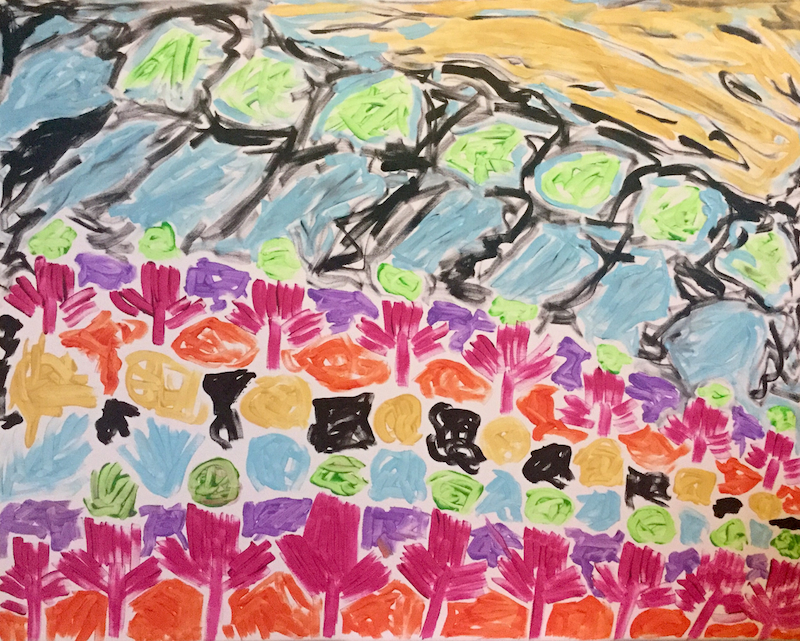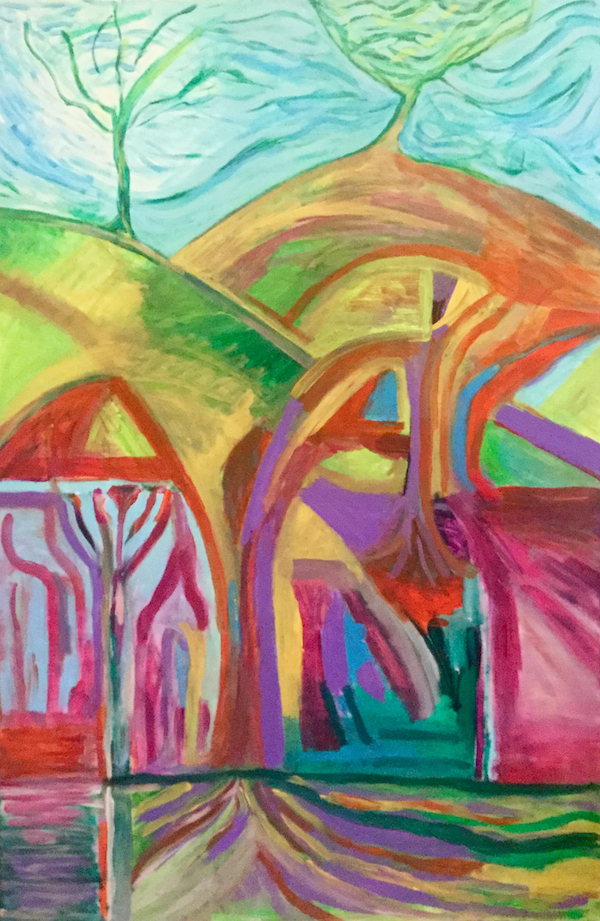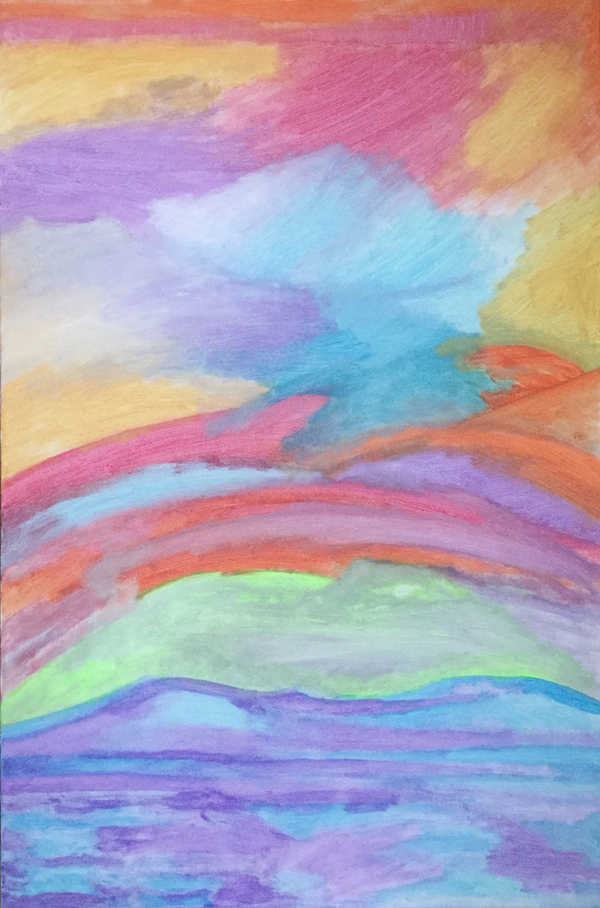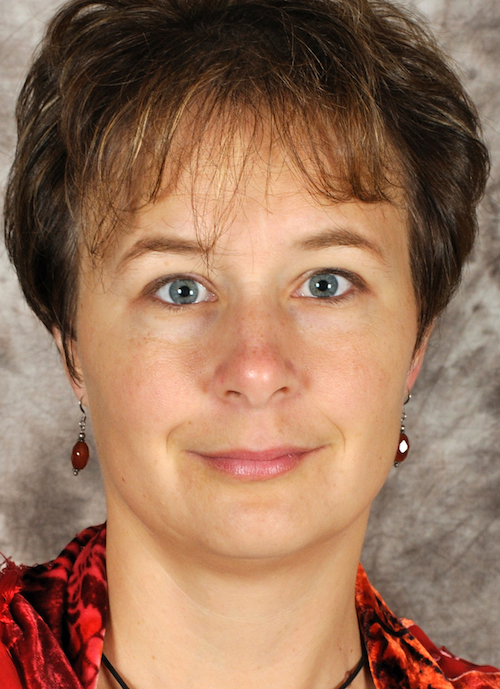Theme Essay by Cynthia Rosi
A Meditation on the Power of Words to Harm—or Heal

In the 1970s, my mother had a desk fitted into a corner of a room on the ground floor of our house in West Seattle. There she kept her King James Bible and, on shelves above it, the Bible history books she used as references. Every morning before school, I’d sit at her elbow and listen to the Bible readings prescribed in the Christian Science Quarterly and then a corresponding set of readings in Science and Health with Key to the Scriptures by Mary Baker Eddy. Our family had been practicing Christian Science for four generations; I was in the fifth.
I snuggled into Mom’s lap, and she explained the meanings of unfamiliar words and phrases. She’d get down the big Webster’s dictionary to look up definitions she couldn’t easily explain. Science and Health with Key to the Scriptures contained rich vocabulary on each of its 700 pages: “suppositious,” “vapid,” “peremptory,” “impugn.” Words were paths toward understanding God. I carried tiny copies of Eddy’s book and the Bible in my backpack and on camping trips, the way other people brought along aspirin. Through discerning the texts in these two books, my mother said, we could align ourselves more closely with Divine Love. This brought healing on a mental level, which then engendered a physical change.
Those words and phrases fed me. They seemed like concrete objects with their own weight and force. I memorized Bible verses and thought about them when I was frightened or in pain. In an experiment that would have been condemned as incompatible with Christian Science principles, I played with the word “headache” in my childhood bed. If I concentrated on the words “headache” or “migraine,” I could create pain in my head. Then I’d say my prayers, and the headache would disappear.
Even when I matured as a writer of poetry and fiction, I couldn’t shake the belief that my words might literally be creating disease in the minds of my readers. I’m no longer a Christian Scientist, but it’s been remarkably difficult to abandon the notion that thoughts are things. The idea is still pervasive in metaphysical and new thought movements, in the assertion that quantum physics validates the philosophy. (Try searching on “thoughts are things.”)
Christian Science originated with Mary Baker Eddy, who said that, starting in 1866, her Bible study led to spontaneous physical healings. She wrote about these healings and her theories in Science and Health with Key to the Scriptures, which was first published in 1875. By the turn of the twentieth century, Eddy had become a formidable positive role model for women, founding a Boston publishing house (the Christian Science Monitor got its start in 1908) and a religion deeply rooted in spiritual healing. Her faith, books, and journals spread all over the world. Today, the influence of Christian Science can be found in the Unity religion, Religious Science, and the positive-affirmation cards of Louise Hay.
Eddy advocated turning thought toward the Divine Mind to bring about healing. But she also addressed evil. “Sin and disease must be thought before they can be manifested,” she wrote. “You must control evil thoughts in the first instance, or they will control you in the second.” She went on to say of immoral teachers:
[T]he debased and unscrupulous mind, though adorned with the gems of scholarly attainment, will degrade the characters it should inform and elevate.
My mother instructed me to skip over passages in the books I read for school if they upset me. As I read, I often argued with the text, praying for a different outcome for the characters. They were alive to me, and I suffered with them. When the author described an injury, I became powerless; my prayers couldn’t affect the outcome.
 Reading was a spiritual experience, intimate and private. “All the arts depend upon telepathy to some degree, but I believe that writing offers the purest distillation,” notes Stephen King in his memoir On Writing. It seemed that way to me, too, particularly since I’d been taught that spiritual reality was the only reality. Through reading, I experienced how other people thought and why they behaved as they did.
Reading was a spiritual experience, intimate and private. “All the arts depend upon telepathy to some degree, but I believe that writing offers the purest distillation,” notes Stephen King in his memoir On Writing. It seemed that way to me, too, particularly since I’d been taught that spiritual reality was the only reality. Through reading, I experienced how other people thought and why they behaved as they did.
This was revelatory to a girl who daily tried to jam the square peg of one Divine Mind into the round hole of middle school kids pushing her in the halls. Despite what Mom said, I could see that every kid had a brain and different thoughts, and there was nothing I could do to change that. This guilty discovery both overwhelmed and exhilarated me.
The first overt conflict between my mother’s expectations and my own experience came when I wrote the poem “To Be the Mountain.” My high school English teacher submitted it to Washington State’s Centrum Foundation. It was included in Centrum’s 1983 Somewhere Down the Road anthology of student work, edited that year by Jim Heynen. In writing it, I’d thought about eternal life and the biblical phrase “watered the earth” from Genesis. But the words “blood” and “spit” in my poem fixed it into physicality. When I showed it to my mother, she made a face. She didn’t approve, she said, because those kinds of words don’t belong in poems. Poetry should reflect beauty and uplift the reader.
During the car journey from Seattle to the awards ceremony in Tacoma, I received instructions from her on how to behave toward the well-known poets. Shake hands firmly, look them in the eye, don’t be loud. But near the Midway garbage dump, the head gasket blew, and we had to pull off the side of the highway and flag down a passing car. We were late. At the gathering, the poets wanted to congratulate me and, by extension, my mother, but she was so embarrassed by the poem she tugged me away. We sat at a table together with nothing to say. It would take me thirty years to realize that, because our religion always marked us as oddities—the people who didn’t believe in doctors—my mother cringed at anything she thought was not socially normal. We knew our manners, and we practiced them.
I stopped showing my poetry and short stories to her, but I continued to write. In exploring my internal dissonance, I was far more in tune with John Gardner’s The Art of Fiction than Science and Health with Key to the Scriptures, although I didn’t know it yet. “Fiction seeks out truth,” Gardner wrote:
[P]art of our interest as we read is in learning how the world works; how the conflicts we share with the writer and all other human beings can be resolved, if at all; what values we can affirm and, in general, what the moral risks are.
Fornication was my first moral risk. When I began to date my first serious boyfriend, that same supportive English teacher recommended Lady Chatterley’s Lover. Sex began to appear in my poetry: beautiful, enjoyable sex. I sought out truth by attempting to describe my forbidden experience. I remained devoted to understanding God, but I’d also discovered my body.
The day I left for college, all packed for the drive to the University of Puget Sound, my mother and I stood in the kitchenette of the one-bedroom apartment where we were living then. Mom always dressed nicely, in a high-necked blouse with a ruffled front and a knee-length black skirt. We’d been best friends in that apartment, like a couple of roommates, even though she was the one in charge.
“Be careful, or you’ll lose your Science,” she said.
In her words, there was more than the usual sadness of a mother seeing her youngest off to college. She was afraid the professors’ ideas—and my Catholic boyfriend—would move me away from my potential as a Christian Science healer. I didn’t believe the way we thought about things could ever separate us, but part of me knew she’d seen the future. Suddenly, I was afraid, too.
 I didn’t lose my faith, at least not right away. At Puget Sound, I habitually skipped over any article that mentioned my religion, because invariably the author would ridicule us. I studied Robert Bly’s work, assuming I could escape—“Get down out of the head and down into the body,” as he said in Talking All Morning—until I came across a claim by another writer that Christian Scientists could never be poets because they couldn’t get down into the body, couldn’t get into the senses.
I didn’t lose my faith, at least not right away. At Puget Sound, I habitually skipped over any article that mentioned my religion, because invariably the author would ridicule us. I studied Robert Bly’s work, assuming I could escape—“Get down out of the head and down into the body,” as he said in Talking All Morning—until I came across a claim by another writer that Christian Scientists could never be poets because they couldn’t get down into the body, couldn’t get into the senses.
The fact that I can no longer remember the name of this author or the article—that I haven’t even been able to track it down with a Web search—may mean nothing or everything about my state of mind then. But I do know I read the article several times and that each reading increased my anxiety. I couldn’t be a Christian Scientist and a poet? Not like my idol Seamus Heaney, whose sensuous poetry placed my body in relationship to my environment?
Repression is like a great, coiled spring: the stronger the spring, the larger the push of energy when it’s released. As an exchange student in England my junior year, I met a nineteen-year-old boy at a bus stop. By the time I graduated from Puget Sound, the need to write, and to be mentally free of religious and sexual repression, was a spring that shot me clear across the United States, over the Atlantic Ocean, and back to London and that boy.
We married, and I took a job as a reporter, which led to me covering crimes: arson, gang violence, domestic knifings and beatings. I made sense of the world by writing crime fiction. Still, after years of indoctrination, I wondered if my words could be harmful to readers, encouraging shadows to spread like tumors where they otherwise wouldn’t grow. I knew this elevated the power of the writer beyond reason. And yet, if you internalize the idea that thoughts are things, words—the building blocks of coherent thought—become dangerous. Instead of exploring the world’s light and dark, under this model, a writer of conscience must create only scenarios of rescue, of disease that is healed, of desires that harmoniously resolve.
It’s difficult programming to break, the fear that by revealing flaws in my characters I actually create evil. Writing, like music, isn’t innocent. The writer’s job is to reflect humanity, not to control the reader’s reaction, which makes writing a bold and risky profession. Once a work is published, readers bring their own beliefs to the encounter. If fiction had no effect on the reader, Salman Rushdie would walk and speak freely instead of living under fatwa for The Satanic Verses. Frank O’Connor’s stories would not have been banned in Ireland, and Mark Twain’s The Adventures of Huckleberry Finn would not head up a list of thirty books highlighted in 2016 for Banned Book Week in the United States.
Recently, I called Mom on a Sunday. She’s in her nineties, living on her own in Seattle, for all appearances in excellent health, and to this day she’s never been in a doctor’s office. She began to give me encouragement in the Christian Science way, which is sweet to hear on difficult days and lifts my spirits. It still provides me with healing.
But writers also have other ideas about what it means to heal. In Zen in the Art of Writing, Ray Bradbury wrote:
We build tensions, especially today, toward sickness and then, if we are good enough, talented enough, observant enough, allow our audiences to be sick.
As a writer, my first priority is to embody, to record human experience. I did not create art itself, nor the function of writing. I am not God. I am a reporter, a distiller, a carver of words.
Publishing Information
- Science and Health with Key to the Scriptures by Mary Baker Eddy, originally published in 1875 (The First Church of Christ, Scientist, 1971).
- On Writing: A Memoir of the Craft by Stephen King (Pocket Books, 2000).
- “To Be the Mountain” by Cynthia King in Somewhere Down the Road: An Anthology of Washington High School Student Poetry and Fiction, edited by Jim Heynen (Centrum Foundation, 1983).
- The Art of Fiction: Notes on Craft for Young Writers by John Gardner (Knopf, 1984).
- Talking All Morning by Robert Bly (Poets on Poetry series, University of Michigan Press, 1980).
- “Banned Books that Shaped America,” on the website of Banned Books Week (September 25–October 1, 2016).
- Zen in the Art of Writing by Ray Bradbury (Capra Press, 1990).
Art Information
- Paintings by Carl Bowlby; used by permission:
- "Black Sky"
- "Roots"
- "Cotton Candy"
 Cynthia Rosi says writing and teaching writing absorb her hours and days. Books, articles, short stories, and poetry engage her mind and fingers. In between, she swims and relaxes with her husband, who owns a winery in Columbus, Ohio. They have two grown children who can both make wine with their feet.
Cynthia Rosi says writing and teaching writing absorb her hours and days. Books, articles, short stories, and poetry engage her mind and fingers. In between, she swims and relaxes with her husband, who owns a winery in Columbus, Ohio. They have two grown children who can both make wine with their feet.
You’ll find more information about her books—The LightCatcher, Motherhunt, and Butterfly Eyes—on Cynthia Rosi’s website.
